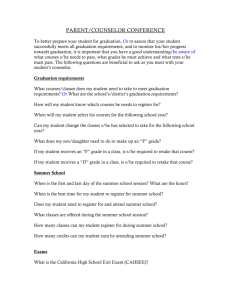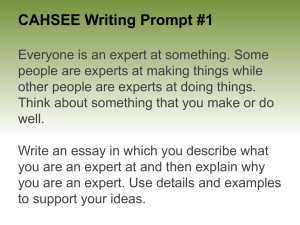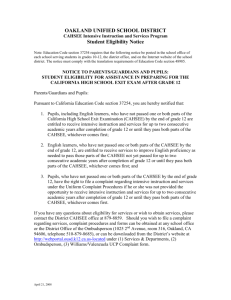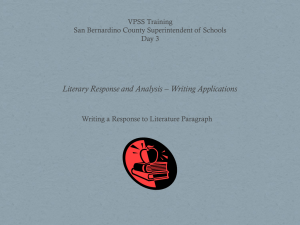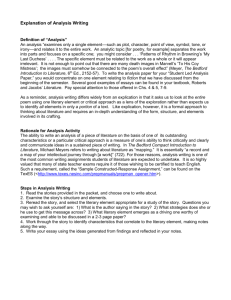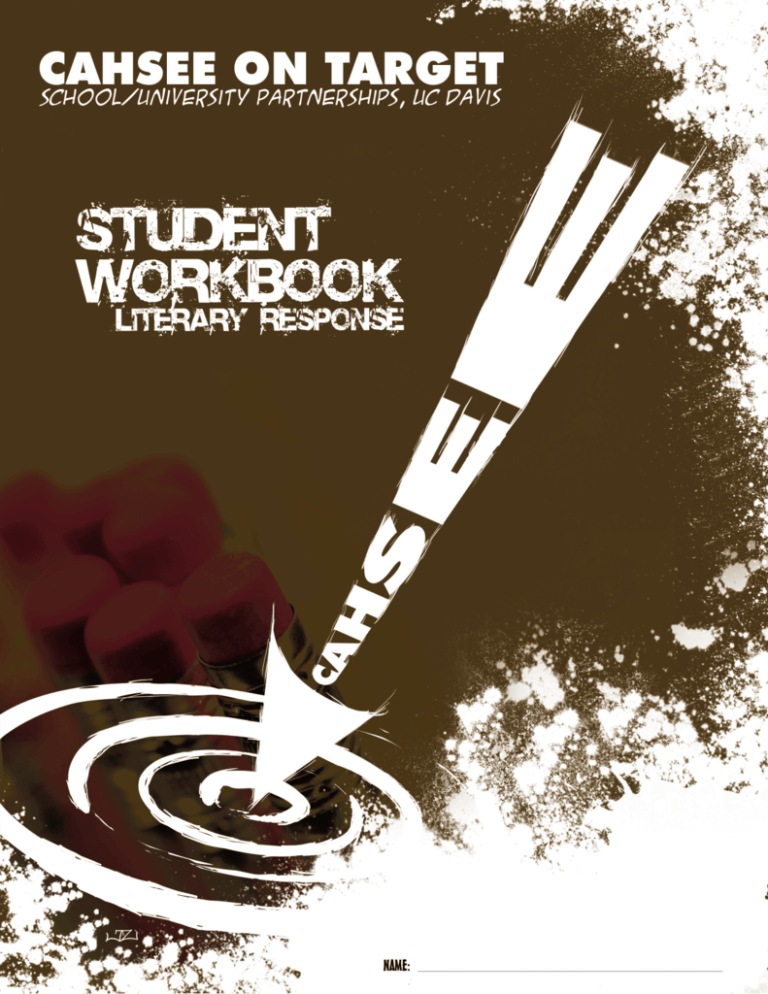
CAHSEE on Target
UC Davis, School and University Partnerships
CAHSEE on Target
English Language Arts Curriculum
Published by
The University of California, Davis,
School/University Partnerships Program
2006
Director
Sarah R. Martinez, School/University Partnerships, UC Davis
Developed and Written by
Syma Solovitch, School/University Partnerships, UC Davis
Reviewers
Jennifer Osborne, UC Davis English Graduate
Faith Paul, School/University Partnerships, UC Davis
Linda Whent, School/University Partnerships, UC Davis
Sarah Rees, School/University Partnerships, UC Davis
Design and Layout
Bo Botelli, Publications Coordinator
Jack Zhang, Publications Assistant
Advising Services, UC Davis
The CAHSEE on Target curriculum was made possible by
funding and support from the California Academic Partnership Program,
GEAR UP, and the University of California Office of the President.
We also gratefully acknowledge the contributions of those teachers
and administrators at Sacramento High School and Woodland High School
who piloted the CAHSEE on Target curriculum.
© Copyright The Regents of the University of California, Davis campus, 2005-06
All Rights Reserved. Pages intended to be reproduced for students activities
may be duplicated for classroom use. All other text may not be reproduced in any form
without the express written permission of the copyright holder.
For further information,
please visit the School/University Partnerships Web site at:
http://sup.ucdavis.edu
CAHSEE on Target
UC Davis, School and University Partnerships
Student Workbook: Literary Response Strand
Introduction to the CAHSEE
The CAHSEE stands for the California High School Exit Exam.
The English Language Arts section of the CAHSEE consists of
72 multiple-choice questions (45 reading items and 27 writing items)
and one essay (accounting for 18% of the section).
The items span across 6 distinct strands:
•Word Analysis: 7 Questions
•Reading Comprehension (Informational Text): 18 Questions
•Literary Response & Analysis: 20 Questions
•Writing Conventions: 15 Questions
•Writing Strategies: 12 Questions
•Writing Applications: 1 Essay (18% of the total score)
What is
CAHSEE on Target?
CAHSEE on Target is a tutoring
course specifically designed for
the California High School Exit Exam
(CAHSEE). The goal of the program is to
pinpoint each student’s areas of weakness
and to then address those weaknesses
through classroom and small group instruction,
concentrated review, computer tutorials and
challenging games.
Each student will receive a separate workbook for
each strand and will use these workbooks during
their tutoring sessions. These workbooks will
present and explain each concept covered
on the CAHSEE, and introduce effective
strategies for reading comprehension,
essay writing, and text revision.
CAHSEE on Target
UC Davis, School and University Partnerships
Student Workbook: Literary Response Strand
Literary Text and the CAHSEE
On the CAHSEE you will be given several passages
to read, followed by a series of multiple-choice
questions that test your understanding of the text.
There are a total of 38 reading comprehension
questions on the CAHSEE: 18 questions based on
informational text and 20 questions based on
literary text.
Like the Reading Comprehension strand of the
CAHSEE, the Literary Response & Analysis tests
your ability to understand what you are reading;
here, however, the emphasis is on literary text.
Literary text refers to passages written in a literary
style, such as poems, short stories, and plays.
A literary style of writing makes use of figurative
language and literary devices to create a
powerful image for the reader.
Figurative Language
Authors use figurative language to help the reader visualize (or see) what is happening
in a story or poem. It is language that uses imaginative comparison, rather than literal
statement, to give the reader a feeling about the subject. When you read poetry or
literature, you must be able to recognize figurative language and understand how
it is used. Here are the most common forms of figurative language:
A. Similes
A simile is a figure of speech that compares two unlike things,
using the words “like” or “as.”
Example: Her hands were as cold as ice.
Example: She moves like a snail.
What does this mean?
_____________________________________________________________________
CAHSEE on Target
UC Davis, School and University Partnerships
Student Workbook: Literary Response Strand
Exercise: Read the following poem and underline all of the similes.
Then answer the questions that follow.
Willow and Ginkgo
The willow is like an etching,
Fine-lined against the sky.
The ginkgo is like a crude sketch,
Hardly worthy to be signed.
The willow’s music is like a soprano,
Delicate and thin.
The ginkgo’s tune is like a chorus
With everyone joining in.
The willow is sleek as a velvet-nosed calf;
The ginkgo is leathery as an old bull.
The willow’s branches are like silken thread;
The ginkgo’s like stubby rough wool.
The willow is like a nymph with streaming hair;
Wherever it grows, there is green and gold and fair.
The willow dips to the water,
Protected and precious, like the king’s favorite daughter.
The ginkgo forces its way through gray concrete;
Like a city child, it grows up in the street.
Thrust against the metal sky,
Somehow it survives and even thrives.
My eyes feast upon the willow,
But my heart goes to the ginkgo.
Eve Merriam
CAHSEE on Target
UC Davis, School and University Partnerships
Student Workbook: Literary Response Strand
1. In which stanza does the author contrast the texture,
or feel of the ginkgo and the willow? How does she distinguish them?
_____________________________________________________________________________
_____________________________________________________________________________
_____________________________________________________________________________
_____________________________________________________________________________
2. In the last stanza, Merriam writes, “My eyes feast upon the willow,
but my heart goes to the ginkgo.” What does she mean by this?
_____________________________________________________________________________
_____________________________________________________________________________
_____________________________________________________________________________
_____________________________________________________________________________
3. Why do you think she feels this way?
_____________________________________________________________________________
_____________________________________________________________________________
_____________________________________________________________________________
_____________________________________________________________________________
Your Turn: Make up three similes of your own. Each simile should contain at least one
adjective.
1. _____________________________________________________________________________
2. _____________________________________________________________________________
3. _____________________________________________________________________________
CAHSEE on Target
UC Davis, School and University Partnerships
Student Workbook: Literary Response Strand
B. Metaphors
A metaphor is a figure of speech that compares two unlike things.
However, unlike a simile, the words “like” and “as” are not used in a metaphor. A metaphor
states that one thing is something else.
Example: Her skin is velvet. (Note: The author does not state that
her skin is “like” velvet or “as soft as” velvet. She states that it is velvet.)
Example: In the following verse from Shakespeare’s Macbeth,
life is compared to a shadow, a player, and a tale.
Out, out, brief candle.
Life’s but a walking shadow, a poor player
That struts and frets his hour upon the stage,
And then is heard no more. It is a tale
Told by an idiot, full of sound and fury,
Signifying nothing.
from Shakespeare’s Macbeth
Exercise: Underline any metaphors in the following poem:
Dreams
Hold fast to dreams
For if dreams die
Life is a broken-winged bird
That cannot fly.
Hold fast to dreams
For when dreams go
Life is a barren field
Frozen with snow.
Langston Hughes
CAHSEE on Target
UC Davis, School and University Partnerships
Student Workbook: Literary Response Strand
Practice: Each sentence below contains either a simile or a metaphor.
Beside each sentence, write an “S” for simile or an “M” for metaphor.
1. Today in class Tim was as sharp as a whistle.
2. Stop being such a mother hen and mind your own business!
3. I’m as blind as a bat without my glasses.
4. The sprinter shot across the field like lightning.
5. Dina is the sunshine to which her parents wake each morning.
6. Henry is as strong as an ox.
7. My sister’s office is a pigpen.
Your Turn: Make up three metaphors of your own.
Each metaphor should contain at least one adjective.
1. ______________________________________________________
2. ______________________________________________________
3. ______________________________________________________
For more exercises go to the following Web site:
http://volweb.utk.edu/schools/bedford/harrisms/1poe.htm
CAHSEE on Target
UC Davis, School and University Partnerships
Student Workbook: Literary Response Strand
C. Personification
Personification means giving human qualities, feelings,
action, or characteristics to non-human objects.
Example: The trees whispered in the wind.
The verb “whispered” is a human action,
while a tree is a non-human object.
Example: The sun poked its head out from the clouds and shone.
Here, the sun is being compared to a person or animal.
These words create a more colorful picture for the reader
than the words, “The sun appeared through the clouds.”
Example: In the following poem, fog, which is a non-human object,
is given the human actions of sitting and looking.
Fog
The fog comes
on little cat feet.
It sits looking
over harbor and city
on silent haunches
and then moves on.
Carl Sandburg
CAHSEE on Target
UC Davis, School and University Partnerships
Student Workbook: Literary Response Strand
Practice: Explain how personification is used in each sentence and the images created
through its use.
1. The chair wept under the weight of the 300-pound man.
_____________________________________________________________________________
_____________________________________________________________________________
_____________________________________________________________________________
_____________________________________________________________________________
_____________________________________________________________________________
2. The angry wind blew onto the man on the narrow road.
_____________________________________________________________________________
_____________________________________________________________________________
_____________________________________________________________________________
_____________________________________________________________________________
_____________________________________________________________________________
_____________________________________________________________________________
Your Turn: Make up three examples of personification.
1. _____________________________________________________________________________
2. _____________________________________________________________________________
3. _____________________________________________________________________________
CAHSEE on Target
UC Davis, School and University Partnerships
Student Workbook: Literary Response Strand
Exercise: Underline all examples of personification in the poem,
and answer the questions that follow.
Little Boy Blue
The little toy dog is covered with dust,
But sturdy and staunch he stands;
And the little toy soldier is red with rust,
And his musket moulds in his hands.
Time was when the little toy dog was new,
And the soldier was passing fair;
And that was the time when our Little Boy Blue
Kissed them and put them there.
“Now, don’t you go till I come,” he said,
“And don’t you make any noise!”
So, toddling off to his trundle-bed,
He dreamt of the pretty toys;
And, as he was dreaming, an angel song
Awakened our Little Boy Blue--Oh! the years are many, the years are long,
But the little toy friends are true!
Ay, faithful to Little Boy Blue they stand,
Each in the same old place--Awaiting the touch of a little hand,
The smile of a little face;
And they wonder, as waiting the long years through
In the dust of that little chair,
What has become of our Little Boy Blue,
Since he kissed them and put them there.
Eugene Field
CAHSEE on Target
UC Davis, School and University Partnerships
Student Workbook: Literary Response Strand
Questions based on “Little Boy Blue” by Eugene Field:
1. What is this poem about?
_____________________________________________________________________________
_____________________________________________________________________________
_____________________________________________________________________________
_____________________________________________________________________________
_____________________________________________________________________________
_____________________________________________________________________________
_____________________________________________________________________________
_____________________________________________________________________________
2. What is the effect of personification in this poem?
_______________________________________________________________________
_______________________________________________________________________
_______________________________________________________________________
_______________________________________________________________________
_______________________________________________________________________
_______________________________________________________________________
_______________________________________________________________________
_______________________________________________________________________
_______________________________________________________________________
For more examples of personification, go to the following Web site:
http://volweb.utk.edu/schools/bedford/harrisms/lesson7.htm
10
CAHSEE on Target
UC Davis, School and University Partnerships
Student Workbook: Literary Response Strand
D. Onomatopoeia
Onomatopoeia is the imitation of natural sounds in word form.
These words help us form mental pictures about the things, people,
or places that are described.
Examples: Bong! Hiss! Buzz! Splash! Crackle! Pop! Moo! Crunch!
Exercise: Read the next poem and underline all onomatopoeias:
The Rusty Spigot
The rusty spigot
sputters,
utters
a splutter,
spatters a smattering of drops,
gashes wider;
slash,
splatters,
scatters,
spurts,
finally stops sputtering
and splash!
gushes rushes splashes
clear water dashes.
Eve Merriam
Your Turn: Write a sentence that uses two or three onomatopoeias.
_________________________________________________________________
_________________________________________________________________
11
CAHSEE on Target
UC Davis, School and University Partnerships
Student Workbook: Literary Response Strand
Review: Read the poem “Corner” by Ralph Pomeroy. Underline all examples of figurative
language and write beside the line “S” for simile, “M” for metaphor, “P” for personification,
or “O” for onomatopoeia. Then answer the question that follows.
Corner
The cop slumps alertly at his motorcycle
supported by one leg like a leather stork
His glance accuses me of loitering
can see his eyes moving like a fish in the green depths of his green goggles
His ease is fake. I can tell.
My ease is fake. And he can tell.
The fingers armored by his gloves
Splay and clench, itching to change something
As if he were my enemy or my death
I just stand there watching,
I spit out my gum, which has gone stale.
I knock out my new cigarette Which is my bravery,
It is all imperceptible:
The way I shift my weight,
the way he creaks in the saddle. The traffic is specific though constant
The sun surrounds me, divides the street between us
His crash helmet is whiter in the shade.
It is like a bullring as they say it is just before the fighting
I cannot back down. I am there.
Everything holds me back.
I am in danger of disappearing into the sunny dust, My Levis bake and my T shirt sweats,
My cigarette makes my eyes burn
But I don’t dare drop it.
12
CAHSEE on Target
UC Davis, School and University Partnerships
Student Workbook: Literary Response Strand
Who made him my enemy?
Prince of coolness, King of fear
Why do I lean here waiting?
Why does he lounge there watching?
I am becoming sunlight
My hair is on fire. My boots run like tar.
I am hung up by the bright air.
Something breaks off all of a sudden
And he blasts off, quick as a craven
Snug in his power; watching me watch.
Question based on “Corner”:
In the last stanza, the author writes, “I am becoming sunlight,
My hair is on fire.” Does the author mean this literally?
Explain the effect created by these words.
__________________________________________________
__________________________________________________
__________________________________________________
__________________________________________________
__________________________________________________
__________________________________________________
__________________________________________________
__________________________________________________
__________________________________________________
__________________________________________________
13
Ralph Pomeroy
CAHSEE on Target
UC Davis, School and University Partnerships
Student Workbook: Literary Response Strand
Other Literary Terms to Learn for the CAHSEE:
1. Climax: the highest point of a story, often where great change occurs
Example: In the reality TV show, The Apprentice, the climax occurs when Donald Trump looks one candidate in the eye and says, “You’re fired!”
2. Conflict: the tension and suspense (A character may be in conflict with himself, another
person, or with natural forces.)
Example: In the play Romeo and Juliet, the conflict arises from the love affair between
two members of rivaling families.
3. Dialogue: a conversation between two or more people
Example:
“I’ve had enough of this nonsense!” exclaimed Emily.
“Well, I haven’t!” retorted Ruth. “In fact, I’m just
getting started!”
4. Flashback: the shifting back to events that took place
at an earlier time, allowing the narrator to compare
what is currently occurring in the story with what
occurred earlier.
Example: The movie, Saving Private Ryan, is told
almost entirely in flashback. We get memories
of the person telling the story and learn, only at
the end of the movie, the identity of this person.
14
CAHSEE on Target
UC Davis, School and University Partnerships
Student Workbook: Literary Response Strand
5. Foil: a character who serves as a contrast to the main character; a character whose traits are
in direct contrast to those of the main character, thereby highlighting or emphasizing the traits
of the main character
Example: Cartoon character Elmer Fudd is the foil for Bugs Bunny. With his baby-like way
of talking and shaky voice, it seems like he is always on the verge of tears. He believes
anything he’s told, thus falling right into Bugs’ trap. Elmer hates being a fool, but Bugs
manages to make a fool out of him every time.
Example: In the Sherlock Holmes stories, Dr. Watson was a foil for Sherlock Holmes. Dr. Watson was average
in every way, while Sherlock was unusual in every way, even eccentric at times.
6. Foreshadowing: a hint, or suggestion, of what’s to come
Foreshadowing serves two purposes:
A. It engages the reader’s interest by building suspense and excitement.
B. It prepares the reader for the events that follow.
Example: In Shakespeare’s
play “Macbeth,” the
conversation among the
three witches foreshadows
the events that will follow.
Example: In horror movies, events are often foreshadowed
through the weather: a character who turns out to be evil
might arrive during a storm in the middle of the night.
15
CAHSEE on Target
UC Davis, School and University Partnerships
Student Workbook: Literary Response Strand
7. Irony: the contrast between what is said and what is meant, or between the appearance
of things and their reality
Examples: The next two poems use irony. Read them and answer the questions that follow.
We Real Cool
We real cool. We
Left school. We
Lurk late. We
Strike straight. We
Sing sin. We
Thin gin. We
Jazz June. We
Die soon.
Gwendolyn Brooks
Explain the use of irony in the poem.
________________________________________________________________________________
________________________________________________________________________________
________________________________________________________________________________
________________________________________________________________________________
________________________________________________________________________________
________________________________________________________________________________
________________________________________________________________________________
________________________________________________________________________________
________________________________________________________________________________
16
CAHSEE on Target
UC Davis, School and University Partnerships
Student Workbook: Literary Response Strand
Happiness
I asked the professors who teach the meaning of life to tell
me what is happiness.
And I went to famous executives who boss the work of
thousands of men.
They all shook their heads and gave me a smile as though
I was trying to fool with them
And then one Sunday afternoon I wandered out along
the Desplaines river
And I saw a crowd of Hungarians under the trees with
their women and children and a keg of beer and an
accordion.
Carl Sandburg
Explain the use of irony in the poem:
________________________________________________________________________________
________________________________________________________________________________
________________________________________________________________________________
________________________________________________________________________________
________________________________________________________________________________
________________________________________________________________________________
________________________________________________________________________________
________________________________________________________________________________
________________________________________________________________________________
________________________________________________________________________________
________________________________________________________________________________
________________________________________________________________________________
17
CAHSEE on Target
UC Davis, School and University Partnerships
Student Workbook: Literary Response Strand
8. Monologue: an extended solo speech by a character in a play (Note: Mono means one.)
For an example of a monologue, see the example for soliloquy.
9. Narrator: the person speaking to us in a story or telling the story
10.Point of view: the angle from which a story is told, most commonly first or third person:
First-person point of view: the narrator is one of the characters in the story
(Note: The pronoun “I” or “me” is used to tell the story.)
Third-person point of view: the narrator is not a character in the story
(Note: The pronoun “he” or “she” is used to tell the story.)
Example: Who do you think is the narrator of this poem?
Two People
She reads the paper,
while he turns on TV;
she likes the mountains,
he craves the sea.
He’d rather drive,
she’ll take the plane;
he waits for sunshine;
she walks in the rain.
He gulps down cold drinks,
she sips at hot;
he asks, “Why go?”
She asks, “Why not?”
In just about everything
they disagree,
but they love one another
and they both love me.
Who do you think is the narrator of this poem?
Eve Merriam
________________________________________________________________________________
18
CAHSEE on Target
UC Davis, School and University Partnerships
Student Workbook: Literary Response Strand
11.Repetition: a technique in which the same word or phrase is repeated throughout a poem
or story in order to highlight or emphasize something.
Example: The following poem contains several examples of repetition. Underline any words
or phrases that are repeated and answer the question that follows.
And They Obey
Smash down the cities.
Knock the walls to pieces.
Break the factories and cathedrals, warehouses
and homes
Into loose piles of stone and lumber and black
burnt wood:
You are the soldiers and we command you.
Build up the cities.
Set up the walls again.
Put together once more the factories and cathedrals,
warehouses and homes
Into buildings for life and labor:
You are workmen and citizens all: We
command you.
Carl Sandburg
What effect is created by the repetition of these phrases?
________________________________________________________________________________
________________________________________________________________________________
________________________________________________________________________________
________________________________________________________________________________
________________________________________________________________________________
12.Setting: the place and time in which a story or play occurs
Example: The setting for the Wizard of Oz is small town in Kansas during the 1940’s.
While the film begins in black and white, it shifts to color when the setting changes
to the Land of Oz.
19
CAHSEE on Target
UC Davis, School and University Partnerships
Student Workbook: Literary Response Strand
13.Soliloquy: a speech that a character makes in a drama in order to show his or her feelings
and inner conflicts (Note: Below is one of the most famous soliloquies in history, from
Shakespeare’s Hamlet.)
To be, or not to be: that is the question:
Whether ‘tis nobler in the mind to suffer
The slings and arrows of outrageous fortune,
Or to take arms against a sea of troubles,
And by opposing end them? To die: to sleep;
No more; and by a sleep to say we end
The heart-ache and the thousand natural shocks
That flesh is heir to, ‘tis a consummation
Devoutly to be wish’d. To die, to sleep;
To sleep: perchance to dream: ay, there’s the rub;
For in that sleep of death what dreams may come
When we have shuffled off this mortal coil,
Must give us pause: there’s the respect
That makes calamity of so long life;
For who would bear the whips and scorns of time,
The oppressor’s wrong, the proud man’s contumely,
The pangs of despised love, the law’s delay,
The insolence of office and the spurns
That patient merit of the unworthy takes,
When he himself might his quietus make
With a bare bodkin? who would fardels bear,
To grunt and sweat under a weary life,
But that the dread of something after death,
The undiscover’d country from whose bourn
No traveller returns, puzzles the will
And makes us rather bear those ills we have
Than fly to others that we know not of?
Thus conscience does make cowards of us all;
And thus the native hue of resolution
Is sicklied o’er with the pale cast of thought,
And enterprises of great pith and moment
With this regard their currents turn awry,
And lose the name of action.--Soft you now!
The fair Ophelia! Nymph, in thy orisons
Be all my sins remember’d.
20
CAHSEE on Target
UC Davis, School and University Partnerships
Student Workbook: Literary Response Strand
14.Stanza: groups of lines that have been separated from other groups of lines in a poem
(Note: Poems consist of stanzas, just as essays and stories consist of paragraphs.
Stanzas are to poems as paragraphs are to essays and stories.)
Example: The following poem is made up of several stanzas.
My Papa’s Waltz
The whiskey on your breath
Could make a small boy dizzy;
But I hung on like death:
Such waltzing was not easy.
We romped until the pans
Slid from the kitchen shelf;
My mother’s countenance
Could not unfrown itself.
The hand that held my wrist
Was battered on one knuckle;
At every step you missed
My right ear scraped a buckle.
You beat time on my head
With a palm caked hard by dirt,
Then waltzed me off to bed
Still clinging to your shirt.
This poem consists of ____ stanzas.
A. one
B. two
C. three
D. four
21
Theodore Roethke
CAHSEE on Target
UC Davis, School and University Partnerships
Student Workbook: Literary Response Strand
15.Tone: The emotion of a piece of writing; a writer shows his attitude toward a subject through
the tone that he uses. Tone can be lighthearted, bitter or gloomy.
Example: Read the next poem and answer the questions that follow.
A Teamster’s Farewell
(Sobs En Route to a Penitentiary)
Good-by now to the streets and the clash of wheels and
locking hubs,
The sun coming on the brass buckles and harness knobs.
The muscles of the horses sliding under their heavy
haunches,
Good-by now to the traffic policeman and his whistle,
The smash of the iron hoof on the stones,
All the crazy wonderful slamming roar of the street-O God, there’s noises I’m going to be hungry for.
Carl Sandburg
1. What is the tone of the poem?
_____________________________________________________________________________
_____________________________________________________________________________
_____________________________________________________________________________
2. What does the poem’s tone convey about the author’s attitude toward the familiar scenes of
every street life?
_____________________________________________________________________________
_____________________________________________________________________________
_____________________________________________________________________________
_____________________________________________________________________________
_____________________________________________________________________________
22
CAHSEE on Target
UC Davis, School and University Partnerships
Student Workbook: Literary Response Strand
Literary Genres on the CAHSEE
Genre means “type” or “kind.” On the CAHSEE, you must know the major genres that occur
in both fiction and non-fiction.
A. Fiction (something made up; something that didn’t happen)
Novel: a long work of fiction that tells the story of fictional characters and events
(Note: Novels generally consist of multiple chapters.)
Short Story: a short work of fiction that tells the story of fictional characters and events
(Note: Short stories do not generally consist of chapters.)
Play: a story to be performed, generally on the stage (Note: Plays generally consist of
two or more acts, and each act consists of various scenes.)
Poem: a piece of writing, often in verse, that is set out in short lines, often with
noticeable rhythm
B. Non-Fiction: something that happened
i. Literary Text
Biography: a book in which the author tells the true story of someone else’s life
Autobiography/Memoir: a book in which the author tells the true story of his or her own life
ii. Informational Text
Article: a piece of writing that gives information about a subject
Essay: a piece of writing in which the author shares his or her reflections, thoughts
and opinions on a certain subject (Note: An essay is always written
from the author’s point of view.)
ESSAY
23
CAHSEE on Target
UC Davis, School and University Partnerships
Student Workbook: Literary Response Strand
Review of Literary Terms
Climax: the highest point of a story, often where great change occurs
Conflict: the tension and suspense in a story
Dialogue: a verbal exchange between two or more people
Flashback: a shifting back to events that took place at an earlier time
Foil: a character who serves as a contrast to the main character
Foreshadowing: a hint, or suggestion, of what’s to come
Genre: type or kind (Literary genres include plays, poems, short stories and
novels)
Irony: the contrast between what is said and what is meant, or between the
appearance of things and their reality
Monologue: an extended solo speech by a character in a play (or sometimes
a poem)
Narrator: the person speaking to us in a story or telling the story
Point of view: the angle from which a story is told (generally 1st or 3rd
person point of view)
Repetition: a technique in which the same word or phrase is repeated
throughout a poem or story in order to highlight or emphasize something
Setting: the place and time in which a story or play occurs
Soliloquy: a speech that a character makes in a drama in order to show his
or her feelings and inner conflicts
Stanza: groups of lines that have been separated from other groups of lines
in a poem
Tone: the emotion of a piece of writing
24
CAHSEE on Target
UC Davis, School and University Partnerships
Student Workbook: Literary Response Strand
Literary Jeopardy: Board
Genres
Literary Terms
Figurative Language
$100
$100
$100
$200
$200
$200
$300
$300
$300
$400
$400
$400
$500
$500
$500
25
CAHSEE on Target
UC Davis, School and University Partnerships
Student Workbook: Literary Response Strand
Review of Question Strategies for the CAHSEE
In the Reading for Information workbook, you learned the five basic strategies for answering
CAHSEE questions. These strategies can also be used in the Literary Response & Analysis strand.
Below is a review of the five basic question types and the strategies that work best for each one.
Question Type
BIG
Idea
Strategy
Right There!
Skim & Scan for a particular
fact & look for an answer in
the same words as the text.
In Other Words...
Skim & Scan for the reference & then
look for an answer stated in different
words from the text. This type of
question tests your comprehension
and ability to “paraphrase”
(summarize) what you have read.
Up Here!
Just use your brain.
No need to go back to the text.
What’s the Big Idea...
Look at big idea places:
1. Title
2. 1st paragraph
3. Last paragraph
beginning
No shortcuts!
Read All!
Read the whole text,
from beginning to end!
end
26
CAHSEE on Target
UC Davis, School and University Partnerships
Student Workbook: Literary Response Strand
Review of Question Strategies
(Continued)
Let’s look at each of these question types in greater detail:
1. Right There!
These questions are based on one detail in the passage. You need to locate the
information and find an answer choice that is stated in the same words as those
used in the passage.
Strategies for “Right There” Questions:
•Skim & scan to find the particular reference
•Look for an answer choice that is stated in the same words:
Below are examples of question stems for “Right There” questions from the Literary
Response strand of the CAHSEE.
Sample Question Stems on the CAHSEE
According to the passage, what did . . . do … ?
What is the play’s setting?
In which stanza of the poem does the author mention ... ?
Where does the drama take place?
27
CAHSEE on Target
UC Davis, School and University Partnerships
Student Workbook: Literary Response Strand
2. In Other Words…
These questions are often based on an idea, rather than a specific and isolated
detail. Find the part in the text that talks about this and then look for an answer
that summarizes the idea. The answer will be stated in different words than
those used in the text.
Strategies for “In Other Words” Questions:
•Skim & scan for the particular section referred to in the question.
•Read what you need: about three to five lines before and three to five lines
after the citation to make sure you understand the content.
•Look for an answer choice in which the fact is rephrased or paraphrased.
Below are examples of question stems for “In Other Words” questions from the
Literary Response strand of the CAHSEE.
Sample Question Stems on the CAHSEE
Which statement best illustrates…?
Which information supports the idea that….?
Which statement best summarizes…?
28
CAHSEE on Target
UC Davis, School and University Partnerships
Student Workbook: Literary Response Strand
3. Up Here!
Certain questions on the CAHSEE test your knowledge of a term or concept and
your ability to recognize an example of that term/concept. Others ask a question
that has one answer choice that would make sense. There is no need to go back
to the text. All the information you need is contained in the question and answer
choices. You can answer the question by using common sense and applying what
you have already learned.
Strategies for “Up Here” Questions:
•Think!
•Apply what you know.
•Consider each answer choice and think about if it makes sense in the context
of the question.
•Cross out answer choices that do not make sense or that do not fully answer
the question.
Below are examples of question stems for “Up Here” questions from the Literary
Response strand of the CAHSEE.
Sample Question Stems on the CAHSEE
Which of the following expressions from the text
is an example of a metaphor?
Which sentence below is an example of a simile?
What is the meaning of the phrase contempt in this sentence?
In which sentence from the passage does the author acknowledge . . . ?
(if there is only one answer that makes sense)
How is Karl a foil character in the drama?
How does the reader know that the story is a dramatic monologue?
29
CAHSEE on Target
UC Davis, School and University Partnerships
Student Workbook: Literary Response Strand
4. What’s the Big Idea?
Big Idea questions ask you to identify the theme or purpose of a passage, the
author’s tone, or the point of view. For these questions, you can often find the
answer in the first and last paragraphs, and sometimes in the title.
Strategies for “Big Idea” Questions:
•Look at the title.
•Look at the first paragraph.
•Look at the last paragraph.
Below are examples of question stems for “Big Idea” questions from the Literary
Response strand of the CAHSEE.
Sample Question Stems on the CAHSEE
This story is an example of which of the following genres of writing?
What is the theme?
Which sentence BEST expresses an important theme in this drama?
What is the author’s purpose?
What is the narrator’s point of view?
Which pair of nouns BEST describes the mood of this poem?
30
CAHSEE on Target
UC Davis, School and University Partnerships
Student Workbook: Literary Response Strand
5. Read All!
Some questions on the CAHSEE ask you to analyze a character’s motivations or
follow the development of the story’s plot and characters. For these questions,
the answer is not directly stated in one place. You must read the entire story
carefully and draw conclusions based on a number of clues.
Below are examples of question stems for “Read All” questions from the Literary
Response strand of the CAHSEE.
Sample Question Stems on the CAHSEE
The narrator MOST likely… because . . . ?
How does the character’s attitude about herself change during the story?
Based on the information in the passage, which of the following is
MOST likely to happen?
What does the character learn in the story?
Why does the author use _____ in the story?
Example: Why does the author use irony in the story?
Why does the character _____ in the story?
Example: Why does the character lie in the story?
Which of the following sentences BEST explains
the main character’s biggest problem in the story?
What kind of person is _____?
What is the organization of the poem?
What is the sequence of events?
What would be a possible solution to . . . ?
31
CAHSEE on Target
UC Davis, School and University Partnerships
Student Workbook: Literary Response Strand
Recognizing “Read All!” Questions
“Read All!” questions will often focus on the feelings or attitudes of a character,
the changes or growth that a single character goes through, on relationships
between characters, and the lessons learned by a character, or on character traits.
Other times, these questions focus on a particular literary technique or device that
reoccurs throughout the passage.
You can usually recognize these types of questions from the beginning. Let’s look at
some “Read All!” questions that appeared on the CAHSEE in the past. Underline the
part of the sentence that lets you know that this is a “Read All!” question:
Example from the CAHSEE of a “Read All” Question:
How does the students’ attitude about the garden change during the play?
Source: The School Garden
Example from the CAHSEE of a “Read All” Question:
Which of the following BEST describes the relationship between Gray Beaver
and White Fang?
Source: White Fang
Example from the CAHSEE of a “Read All” Question:
Which of the following strategies does the author use MOST frequently
to describe California?
Source: California: A Tribute
32
CAHSEE on Target
UC Davis, School and University Partnerships
Student Workbook: Literary Response Strand
Quiz on Question Types for the CAHSEE
Directions: For each CAHSEE question in the first column, write the “Question Type”
in the second column. (Note: The answer choices are not given, nor are they
needed to identify the type of question.)
Choose from the following:
Right There!
In Other Words...
Up Here!
What’s the Big Idea?
Read All!
Question
?
Question Type
What is the main purpose of Darrow’s article?
Which of the following BEST describes the
relationship between Gray Beaver and White Fang?
Which sentence BEST describes the theme?
What does the word eccentricities mean in the
following sentence from the passage?
Which of the following is NOT a correct rewording
of the following sentence?
What tone does the author establish in the article?
Which sentence from the story contains an example
of a simile?
How does Annie’s father feel when Wei and
Frances arrive?
How is Karl a foil character in the drama?
According to the article, why is it surprising that
Wyoming was the first state to allow women to vote?
From whose point of view is the action in
this story seen?
33


